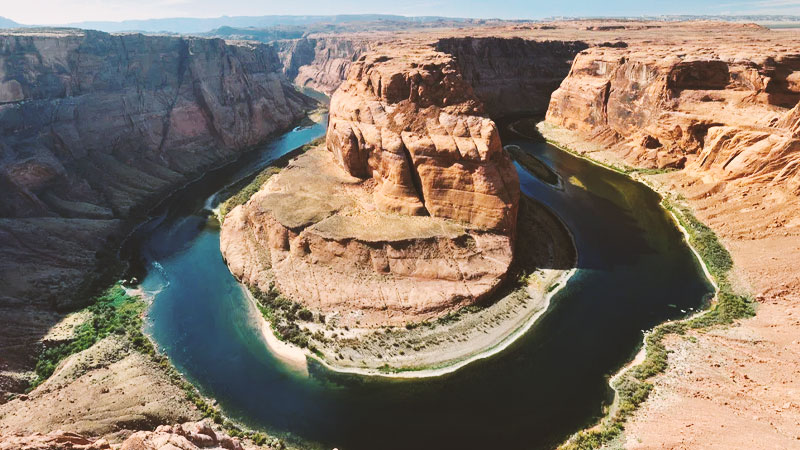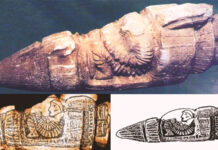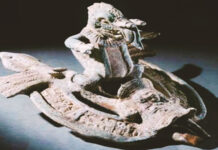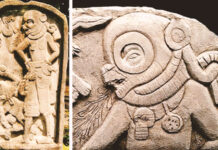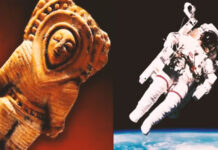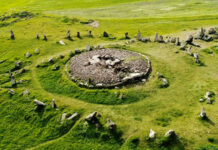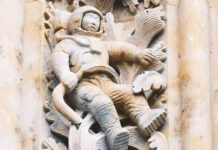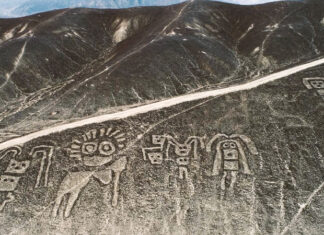The Grand Canyon is a huge canyon over 440 km long, up to 29 km wide and 1.8 km deep, located in the State of Arizona in the United States, this incredible formation has been carved by the Colorado River over the past 40 million years.
For thousands of years, the area has been continuously inhabited by native Americans, and the Pueblo tribe considered the Grand Canyon a sacred site and made pilgrimages to it.
During the period between the late 1800s and the early 1900s, many incredible stories were published in U.S. newspapers mentioning huge cities found inside caves in the Grand Canyon, with references to giants, Egyptians, and other Southeast Asian cultures that would have built and inhabited the site.
The most famous of these reports appeared in the April 5, 1909 issue of The Arizona Gazette, a long front-page story that provided a highly detailed report of the discovery.
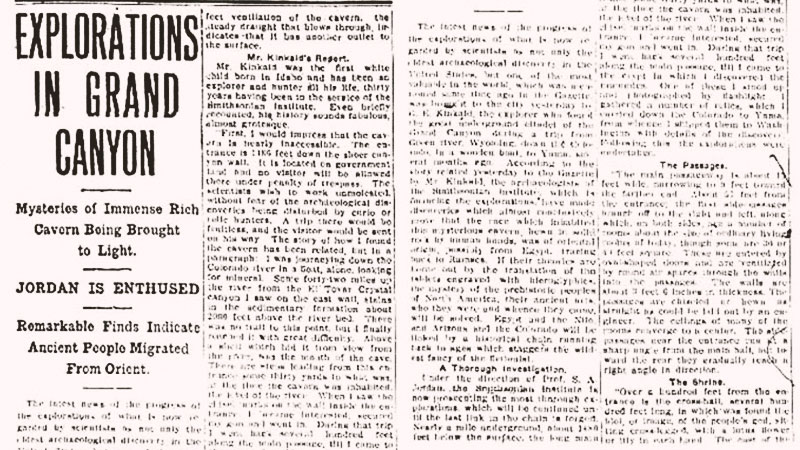
The article, titled “Explorations in the Grand Canyon: Mysteries of an immense and rich cave being brought to light,” talks about the discovery of an underground city by G explorers. And. Kinkaid and S.A. Jordan, both archaeologists from the Smithsonian Institute, as they descended the Colorado River in a small dinghy.
“Discoveries that prove almost conclusively that the race that inhabited this mysterious cave, carved in solid rock by human hands, was of eastern origin, possibly from Egypt, dating back to Ramses. If their theories are confirmed by the translation of the tablets engraved with hieroglyphics, the mystery of the prehistoric peoples of North America, their ancient arts, who they were and where they came from, will be solved. Egypt and the Nile, and Arizona and Colorado will be linked by a historical chain dating back to eras and confusing the wildest fantasy of the fictionist.”
Exploring a small tunnel found on one of the walls of the Grand Canyon, which stretched for more than a kilometer, Kinkaid found the citadel with an architecture that demonstrates that the builders were highly advanced in their engineering skills. In the middle of the city, there was a chamber that radiated several passages.
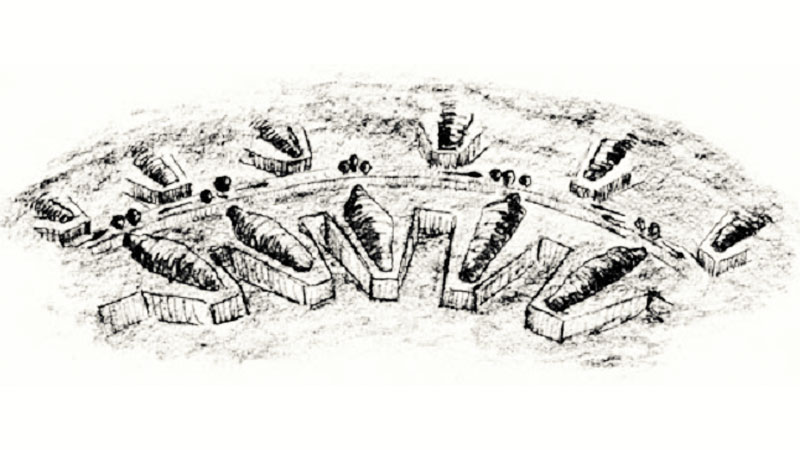
In one of the chambers explored by Jordan and Kinkaid, considered a ceremonial crypt with hieroglyph symbols, similar to those found in Egypt, carved on the walls, mummies covered in clay and spun in tree bark and some kind of dark fabric were found. All mummies were male and there were no children or women, and most impressively, none of the mummies measured less than 2.7 meters.
Another mystery was the discovery of a large Buddha-like statue found in one of the caves, which suggested that the inhabitants of the time were also of Asian origin.
“More than thirty meters from the entrance is the cross-sectional corridor, several hundred meters long, in which is the idol, or image, of the god of the people, sitting cross-legged, with a lotus flower or lily in each hand. The mold of the face is oriental, and the sculpture this cave. The idol almost resembles Buddha, although scientists are not sure what religious cult it represents.“
Ceramics, tablets with hieroglyphics, tools and other copper instruments were also discovered according to the information published in the article.

After these events, in the quest to find the truth, historian Carl Hart, editor of World Explorer magazine, acquired a map of the Grand Canyon and was surprised to find that a considerable part of the north side of the Grand Canyon had areas named after Egyptian gods such as Ra’s Tower, Seth Tower, Temple of Osiris, Temple of Horus, and Temple of Isis.
Other names such as Pyramid of Cheops, Buddha Temple, Buddha Cloister, Manu Temple, and Shiva Temple are also found in this area.
This varied mix of cultures is difficult to find in archaeological finds and so this discovery has unprecedented importance.
The Smithsonian Institute
The Smithsonian Institute is a museum-associated research institution run by the United States government, founded in 1846 with the goal of “establishing the expansion and dissemination of knowledge among men” and, as expected, categorically denied all statements published in the newspaper.
Part of the report said the institute funded the exploration of the cave network, which was so large that 50,000 people would easily fit, and according to Kincaid and Jordan, a team of 40 archaeologists would have collected and sent the artifacts to the Smithsonian and the caves kept under surveillance and off-limits to visitors.

There are no records of jordan or kincaid archaeologists in the Smithsonian’s Department of Anthropology and no even details about this expedition.
A representative of the Smithsonian Institute said at the time, “Well, the first thing I can say, before we go on, is that no Egyptian artifact of any kind was found in North or South America. So I can say that the Smithsonian Institute has never been involved in any of these excavations.”
No one really knows what happened to Kincaid or Jordan, but if one day their accounts turn out to be true, they will redefine the history of America and question a lot about the maritime abilities of the ancient Egyptians and Asians.
The Buried City of Missouri
Another very interesting story, from April 9, 1885, published in The New York Times titled, “Buried City of Missouri: A Strange Discovery in a Coal Mine near Moberly,” revealed a discovery that preceded the Citadel of the Grand Canyon in 24 years.
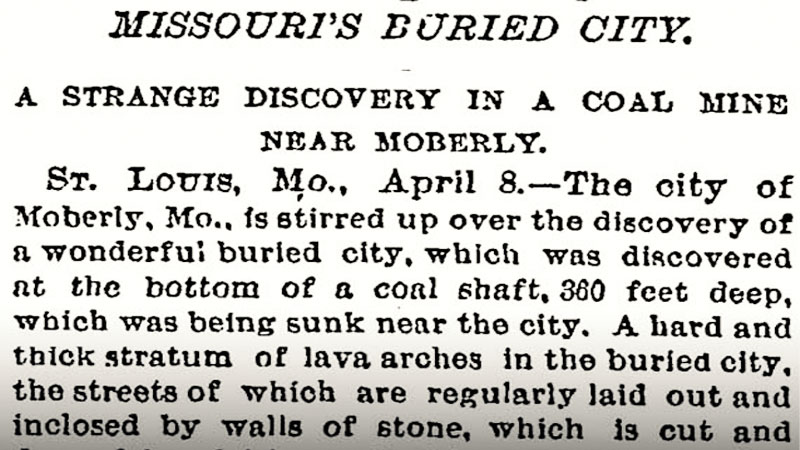
Moberly was the largest city in Randolph County, Missouri, and had a population of 6,108 at the time.
Coal miners, drilling a well 100 meters deep, came across a cave revealing “a wonderful buried city, with streets regularly arranged and surrounded by stone walls, which are cut and coated in a rather good masonry style, albeit rude. Further research revealed statues and images made of a composition very similar to bronze, but without brightness,” the article states.
The workers, along with city clerk David Coates and Sheriff George Keating, found a large 10-foot-by-30-meter courtyard filled with stone benches, hand tools and a fountain that still poured perfectly pure water into their basin, but what intrigued the people who explored the site was what was next to the fountain.
“Next to the foundation of the fountain, there were sections of a human’s skeleton, the leg bones were measured, the femur was 1.4 meters and the tibia 1.2 meters, showing that when alive, the figure was three times the size of an ordinary man, and should possess wonderful muscular strength and agility,” reported The New York Times.
The skull, according to the news, was shattered, but brass tools, granite hammers, metal saws and flint knives were scattered everywhere. “They are not as polished, nor made as accurately as those now finished by our best mechanics, but they show skill and evidence of an advanced civilization that is very wonderful,” the article details.
According to The New York Times, the explorers would have spent twelve hours exploring the buried city, returning to the surface only after the oil from their lamps ran out. “The wonders of discovery have not come to an end. A new extended search will be done in a day or two.“
However, no extended search records have been found and the mine has been mysteriously abandoned since then.
The Hopis Tradition

The Hopi Indians believed that their ancestors lived in the underworld of the Grand Canyon, ruled by a chief named Machete.
The population of this underground world consisted of two types of people: those with one heart and those with two hearts.
A divergence between the two groups resulted in the expulsion of those with a single heart to the surface, where they began to grow grains and corn on the banks of the Colorado River.
A messenger from the tribe was sent to the Temple of the Sun to ask for blessings of peace and goodwill and rain for his crops, but the messenger never returned.
Even today, the old Hopi follow the tradition of contemplating the sunset, looking for the messenger they believe will one day return, restoring their lands.
This tradition was recorded by artist Warren E. Rollins lived with native Americans in the early 1900s, painting the Hopi, the Navajo and the Zuni and their ancient ruins in the Grand Canyon region.

